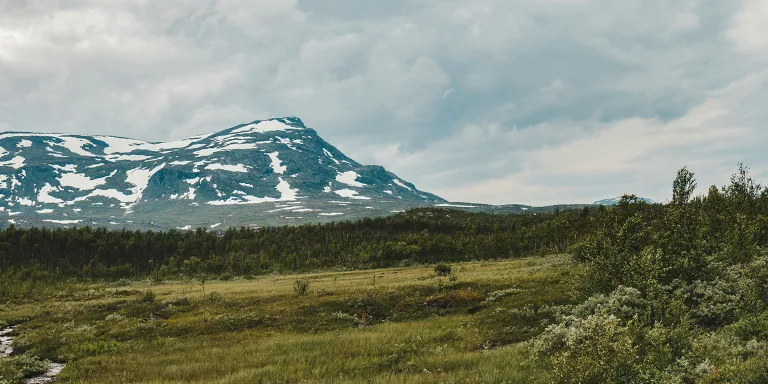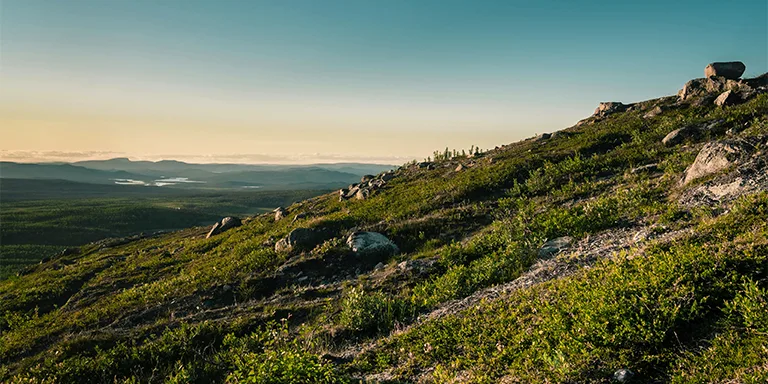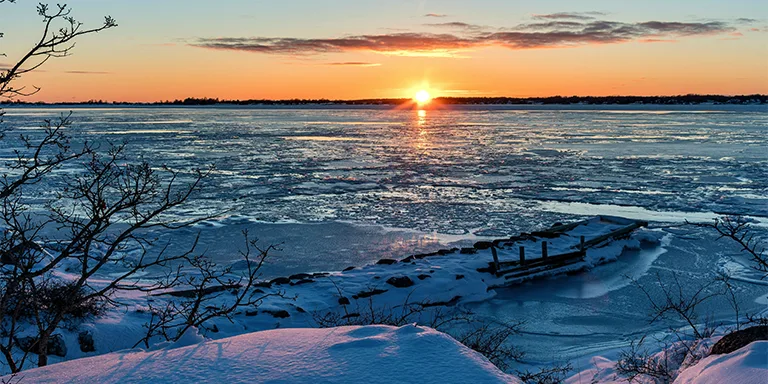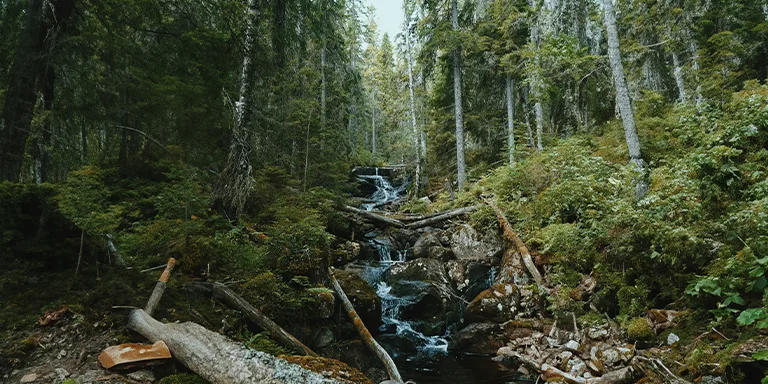

Backpacking in Sweden offers immense variety for outdoor enthusiasts, from the jagged mountains of northern Sweden to the scenic coastlines of the Baltic Sea, including popular destinations like Abisko National Park.
And that’s what this post is all about – backpacking in Sweden. We’ll provide tips to help you prepare for backpacking in this diverse country as well as showcase the best multi-day trails in Sweden.
Whether you’re an experienced thru-hiker or new to backpacking, the tips and trails highlighted in this guide will inspire your next adventure.
Let’s get started.
Discover the most stunning long trails in Sweden for amazing adventures:

Length: 62.9 mi / 101.2 km
Type: Point to point
Difficulty: Hard
Elevation Gain: 7618 ft / 2322 m
Location: Abisko National Park
Estimated Hiking Calorie Burn: 15 100 calories
More Details: See on AllTrails
Stretching 63 miles from Abisko to Nikkaluokta through varied Swedish mountain scenery, this route takes experienced backpackers around 3 days to complete along the royal trail. Mountain cabins spaced along offer amenities or backpackers can camp. Early summer offers 24-hour daylight ideal for this challenging route. You should prepare for potential issues like mosquitoes, and river crossings. The trail rewards with scenic backcountry wilderness immersion and experiences in Northern Sweden’s remote landscapes.

Length: 70 mi / 112.6 km
Type: Point to point
Difficulty: Hard
Elevation Gain: 7536 ft / 2297 m
Location: Abisko National Park
Estimated Hiking Calorie Burn: 17 240 calories
More Details: See on AllTrails
This 70-mile point-to-point trail winding through two valleys in Sweden offers stunning nature. As part of the popular Kingstrail, mountain cabins spaced every 10-12 miles provide amenities. Considered challenging, the rough terrain trail with rocks and swampy areas rewards hikers and backpackers with beautiful scenery over 28 hours in May through September.

Length: 25.1 mi / 40.4 km
Type: Loop
Difficulty: Hard
Elevation Gain: 2883 ft / 879 m
Location: Olofström
Estimated Hiking Calorie Burn: 7200 calories
More Details: See on AllTrails
This 25-mile loop trail near Olofström, Sweden offers a challenging route through varied terrain in about 10 hours. Well-marked with orange arrows, the multi-use trail mixes dirt roads and forest paths with some technical rock sections and steep climbs. Campsites and shelters spaced further apart than water sources pose challenges. Navigation and route planning are important for enjoying this route.

Length: 65.8 mi / 105.9 km
Type: Point to point
Difficulty: Hard
Elevation Gain: 9301 ft / 2835 m
Location: Abisko National Park
Estimated Hiking Calorie Burn: 17 700 calories
More Details: See on AllTrails
This 65.8-mile point-to-point trail between Abisko and Vakkotavare offers a challenging route through Sweden’s most beautiful mountain landscape. As part of the Kungsleden trail, planked walkways aid sometimes rocky or eroded sections. Considered a top five trail by many, popular amenities like mountain huts spaced every 10-15 miles make this an enjoyable series of walks taking around a week to complete in June through September.

Length: 79.6 mi / 128.1 km
Type: Point to point
Difficulty: Hard
Elevation Gain: 10 374 ft / 3162 m
Location: Skuleskogen National Park
Estimated Hiking Calorie Burn: 22 370 calories
More Details: See on AllTrails
This 79.6-mile Swedish coastal trail is challenging and scenic, stretching over 13 stages from Hornöberget to Örnsköldsvik. Known as the Höga Kustenleden, it traverses coastal and forested terrain in the High Coast region from May through October. Taking around 34 hours, backpackers encounter villages and travelers along one of Sweden’s most beautiful long-distance trails through the archipelago and varied landscapes.
In Sweden, the annual average weather varies across regions, but here’s a general overview:
Spring (April to June): Temperatures range from 30-60°F (0-15°C). Spring brings longer daylight hours, blossoming landscapes, and moderate conditions. However, it can be damp.
Summer (July to August): This is peak hiking season. Temperatures range from 55-75°F (15-25°C). Days are long, providing ample daylight for outdoor activities. July and August are generally drier with occasional rain.
Fall (September to October): Temperatures start dropping, ranging from 30-55°F (0-15°C). Fall foliage is vibrant, but there’s an increased chance of cooler and damper conditions.
Winter (November to March): Winter is cold, with temperatures often below freezing. Snow is common, especially in the northern parts. Winter sports like skiing and snowshoeing are popular during this period.
Before you grab your backpack and head outdoors, take a look at the weather statistics for Sweden (Stockholm):
| Jan | Feb | Mar | Apr | May | Jun | Jul | Aug | Sep | Oct | Nov | Dec | |
|---|---|---|---|---|---|---|---|---|---|---|---|---|
| High °F | 32 | 33 | 39 | 49 | 60 | 66 | 71 | 69 | 60 | 49 | 41 | 35 |
| Low °F | 24 | 23 | 27 | 33 | 42 | 50 | 55 | 53 | 46 | 39 | 32 | 26 |
| Rain/Snow (D*) | 6 | 5 | 5 | 6 | 6 | 8 | 8 | 9 | 8 | 8 | 9 | 8 |
Not sure if Sweden is right for you?
Don’t forget to check out our backpacking guides for Finland and Norway.
In Sweden, you can usually have campfires when camping, but there are rules. You must get permission from the landowner, and you can’t have fires during dry times when there’s a high risk of forest fires. There are also rules about building fires safely, like picking the right spot, clearing the area, having water nearby, and putting the fire out completely. Some national parks and nature reserves, especially in the backcountry, might have more rules or ban campfires. But, in general, campfires are a common and enjoyed part of camping in Sweden.
Whether day hiking or embarking on a multiday backpacking adventure, travelers venturing into Sweden’s vast wilderness areas should always be prepared. File a detailed itinerary with someone trusted and carry essential gear like maps, first aid, extra layers. Before trekking off-trail, ensure proper outdoor skills and orienteering ability. In remote areas, consider a personal locator beacon. Natural hazards include unpredictable weather, rocky terrain, large wildlife like moose – proper footwear and attire protects explorers. For outdoors enthusiasts touring Sweden’s magnificent scenery rich with fjords, forests and fells, following basic wilderness safety practices empowers one to fully experience nature’s beauty while significantly reducing risks that could cut travels short.
When hiking in Sweden, you may encounter wildlife like moose, bears, wolves, lynx, deer, foxes, and more. Generally, keep your distance and do not approach or feed the animals. Make noise as you hike to avoid surprising them. Be extra cautious around moose, especially females with calves, bears, and wolves, staying downwind and giving them a wide berth. Know proper deterrents like bear spray for aggressive encounters. Stay calm, don’t run, and back away slowly. Be aware of signs like tracks and scat. Hike in groups when possible.
The main differences between hiking in Sweden versus Norway are the terrain, trails, and crowds. Sweden tends to have gentler, rolling forest lands while Norway is known for its steep, dramatic fjords and mountains. Sweden generally has more established hiking trails and signage, making it easier for beginners and casual hikers. Norway’s trails are often steeper, requiring more advanced hiking skills. Sweden’s trails and national parks also draw bigger crowds than Norway’s more remote trails. However, both offer beautiful scenery from waterfalls and villages to glaciers and wildlife. Overall, hiking in Sweden may be easier and more accessible, while Norway provides more solitude and challenging terrain.
Some of the best national parks to visit in Sweden are Sarek National Park, which is famous for its stunning glaciers, peaks, and valleys; Abisko National Park, known for its beautiful northern lights and hiking trails; Gotska Sandön National Park, a remote island with sandy beaches and rare animals; Hamra National Park, where you can camp in the wild forest; Padjelanta National Park, which has huge open plateaus; Stora Sjöfallet National Park, with loud waterfalls and ancient forests; and Fulufjället National Park, an untouched place with icy lakes. Sweden’s national parks have diverse landscapes, ranging from the Arctic Circle to the shores of the Baltic Sea. You can enjoy various nature activities like hiking, camping, watching the Northern Lights, and encountering wildlife.
U.S. citizens do not need a visa to travel to Sweden for shorter visits. You can legally visit Sweden for up to 90 days without applying for a visa first. This allows Americans to travel freely to Sweden for tourism.